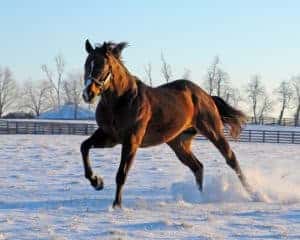Equine Proliferative Enteropathy: Developing a Challenge Model (AAEP 2010)
- Topics: Article
It isn't every day that a new disease or ailment is discovered, as many of the most common equine health problems have been around for several decades, if not centuries. But within the past decade a new disease has emerged that appears most frequently in weanlings. The disease is equine proliferative enteropathy (EPE), a gastrointestinal disease that causes excessive weight loss and stunted growth in foals.
Because veterinarians only recently discovered EPE, little research has been completed on it. But Allen E. Page, DVM, of the University of Kentucky, has developed a challenge model for EPE, a breakthrough that he discussed at the 2010 American Association of Equine Practitioners Convention, held Dec. 4-8, 2010, in Baltimore, Md.
The bacterium Lawsonia intracellularis is the causative bacterial agent for EPE, which is characterized by diarrhea, depression, fever, inappetance (anorexia), weight loss, edema (fluid accumulation in the skin) of the throat latch, ventral abdomen, or lower limbs, a poor hair coat, and intermittent colic (due to thickening of the mucosal lining in the small intestine). Most of the knowledge that equine veterinarians possess about this disease is from the research that has been done in swine, in which L. intracellularis was noted long before it appeared in horses.
The disease typically is not fatal, providing that a diagnosis is made early and the foal receives proper medical treatment. Even then, however, the foal likely will have suffered severe weight loss and stunted growth; affected foals might have a smaller overall stature than unaffected ones, although research into this aspect of EPE is lacking
Create a free account with TheHorse.com to view this content.
TheHorse.com is home to thousands of free articles about horse health care. In order to access some of our exclusive free content, you must be signed into TheHorse.com.
Start your free account today!
Already have an account?
and continue reading.

Related Articles
Stay on top of the most recent Horse Health news with

















